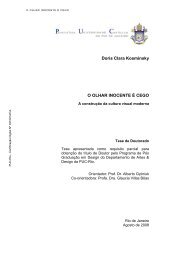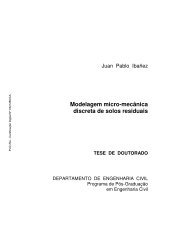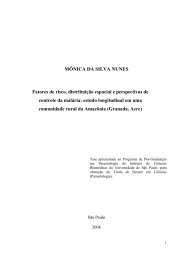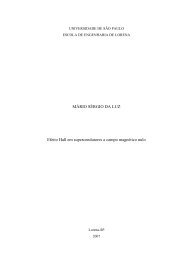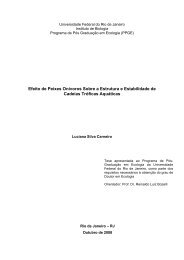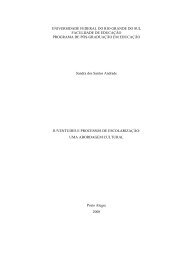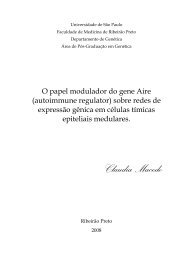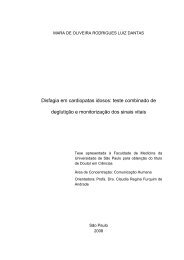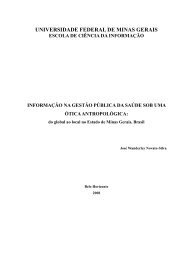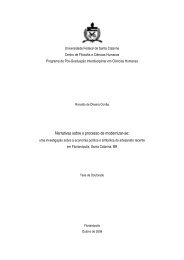Materiais moleculares funcionais contendo n-heterociclos - capes
Materiais moleculares funcionais contendo n-heterociclos - capes
Materiais moleculares funcionais contendo n-heterociclos - capes
Create successful ePaper yourself
Turn your PDF publications into a flip-book with our unique Google optimized e-Paper software.
R. Cristiano et al. / Tetrahedron 63 (2007) 2851–28582853pyrazine and 4-methoxyphenyl rings due to the C1–C11and C2–C21 bond distances (1.475(3) and 1.480(3) Å,respectively), which are a little shorter than typical C–C sbonds (1.53 Å), and this is in agreement with a similar structurepublished in the literature. 12 Intermolecular packing ofthis molecule is based on van der Waals forces and the presenceof an intermolecular p,p-stacking between the ringsC21–C26 and C1–N6. The centroid–centroid distancebetween them is 3.684 Å.2.3. Absorption and fluorescence propertiesFigure 2. Molecular structure of compound 8 with atom labeling scheme.Selected bond distances and angles: C(1)–N(6) 1.341(2), C(1)–C(2)1.434(3), C(1)–C(11) 1.475(3), C(2)–N(3) 1.335(3), C(2)–C(21) 1.480(3),N(3)–C(4) 1.345(3), C(4)–C(5) 1.386(3), C(5)–N(6) 1.341(3), C(1)–C(2)–N(3) 120.76(19), C(2)–N(3)–C(4) 117.66(18), N(3)–C(4)–C(5) 121.6(2),C(4)–C(5)–N(6) 121.45(19), C(5)–N(6)–C(1) 117.99(18), N(6)–C(1)–C(2) 120.1(2).As shown in Figure 2, the two 4-methoxyphenyl groups connectedto positions 5 and 6 of 2,3-dicyanopyrazine aretwisted with respect to each other and they are not coplanarwith the central pyrazine ring. The planes of both 4-methoxyphenylrings are rotated with respect to the mean plane ofthe pyrazine ring by 40.39(6) and 48.36(5) , and with respectto each other by 48.95(6) . The nonplanarity of thiscompound is clearly caused by the steric hindrance betweenC16–H and C22–H. Despite the lack of planarity, some limitedforms of p-conjugation may be occurring between theThe UV–vis and fluorescence spectroscopic data in chloroformsolution and in thin film for the 2,3-dicyanopyrazinederivatives are summarized in Table 1. In dilute solution,all the compounds exhibit two maxima absorption wavelengthspeaking at around 270–310 and 350–380 nm,respectively. The highest and lowest energy absorptionbands are assigned to p–p* transitions due to their high molarabsorption coefficients. These compounds display blueemission in solution (l maxem 440–480 nm) with quantum fluorescenceyields (F F ) from 0.003 to 0.1 and Stokes shifts ofaround 90 nm. The luminescence of these compounds maybe attributed to p–p* fluorescence of the 2,3-dicyanopyrazinering.Figure 3 shows the UV–vis absorption and fluorescencespectra in solution of the intermediate compounds 8 and10. The presence of free hydroxyl groups in compound 10led to a hypsochromic shift of around 10 nm in the spectraand also led to a lower quantum yield. The final compounds11–16 exhibit similar absorption and fluorescence patternsin the curves (Fig. 4). Compound 13 showed a bathochromicshift of around 80 nm in the highest energy absorption banddue to its additional phenyl conjugated ring, but this had noeffect on the Stokes shift.Table 1. Optical absorption and emission spectroscopic data for 2,3-dicyanopyrazine derivativesCompdl maxabs /nma (3/10 4 ) bl maxem /nma,c Stokes shift/nm a F Fdl maxabs /nmfl maxem /nmf,c Stokes shift/nm f E g opt /eV8 383 (2.4) 482 99 0.101 385 492 107 2.99314 (1.9) 31710 372 (2.3) 470 98 0.053 388 — g — 2.92305 (2.0) 32011 350 (2.1) 444 94 0.008 372 430 58 3.14268 (4.6) 25512 348 (1.9) 437 89 0.003 342 512 174 3.30283 (3.2)13 359 e (2.5) 445 86 0.010 367 e 456 89 3.23309 (5.9) 30514 347 (2.0) 438 91 0.007 353 432 79 3.25276 (7.2) 27315 347 (2.5) 438 91 0.007 347 498 151 3.32282 (6.1) 28216 348 (2.4) 440 92 0.005 348 488 140 3.28281 (5.1) 280a 2,3-Dicyanopyrazine derivatives of 10 5 M in chloroform.b Units¼mol1 cm 1 .c Excitation wavelength was at lowest energy maxima of absorption.d Quantum yield of fluorescence using quinine sulfate in 1 M H 2 SO 4 as standard (F F ¼0.546).e Shoulder peak.f In solid thin film.g Diphenol 10 is not fluorescent in solid state.



